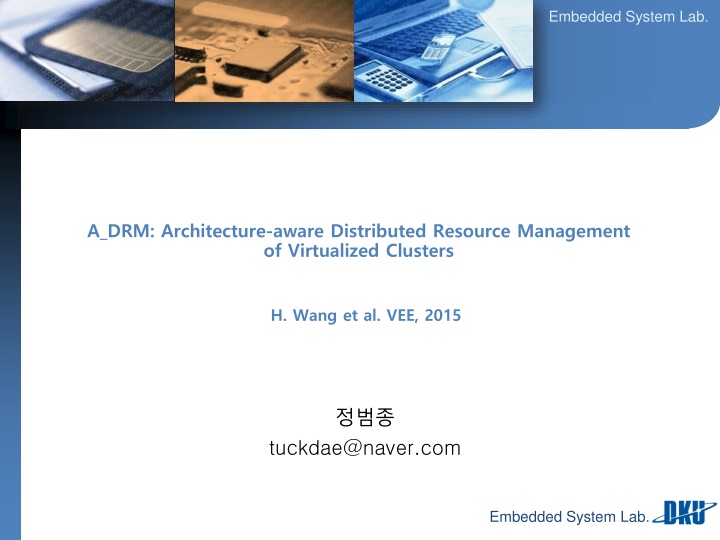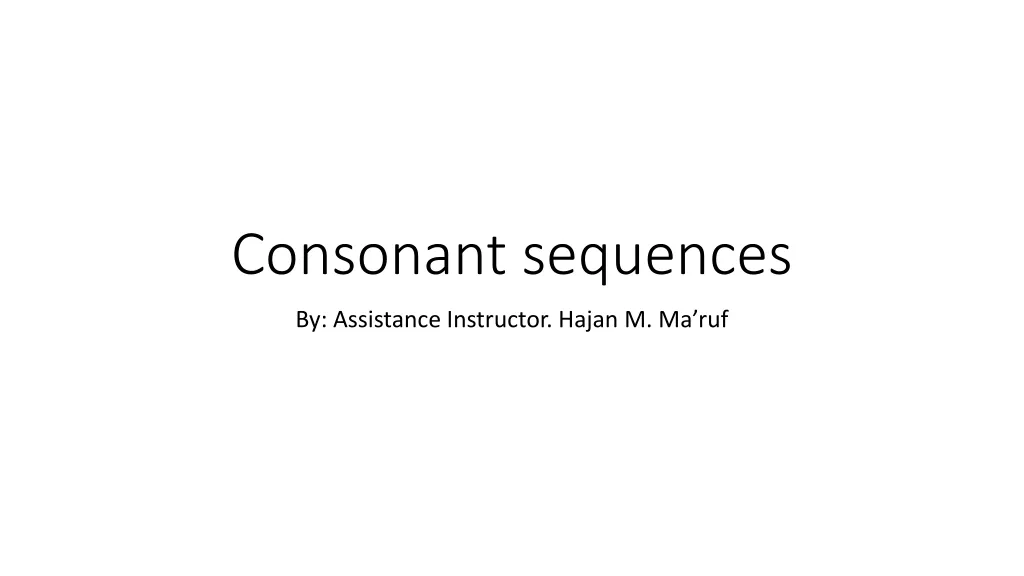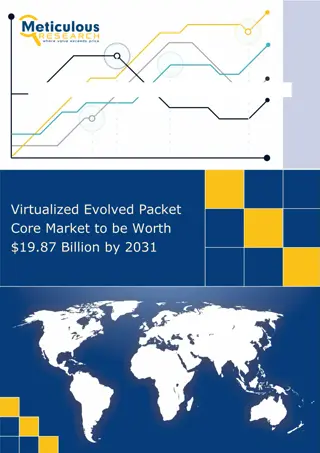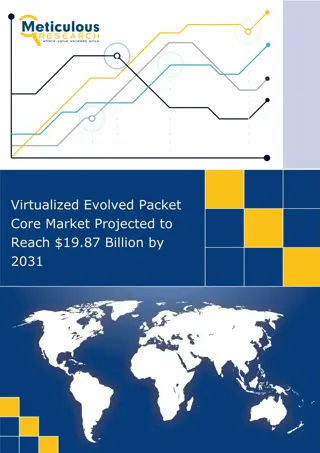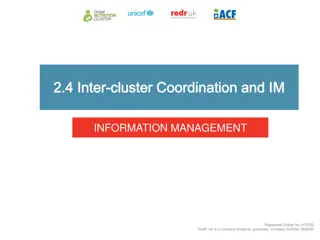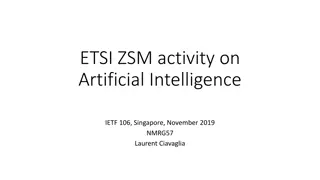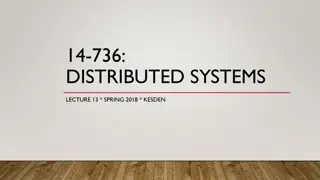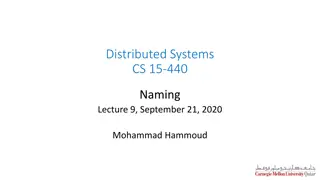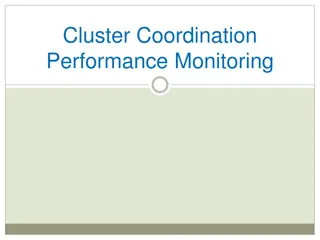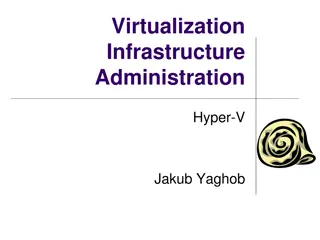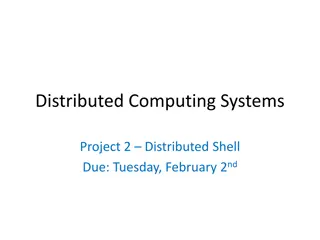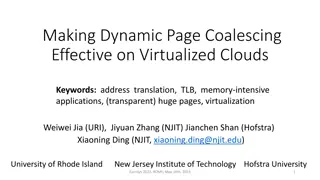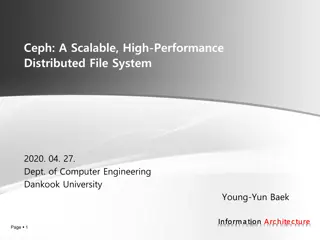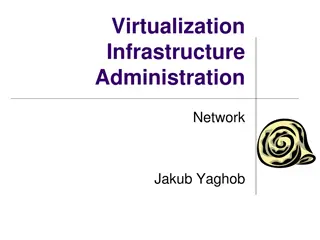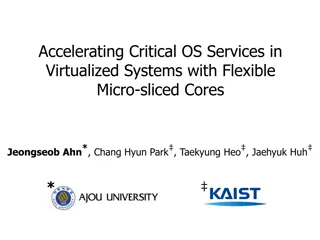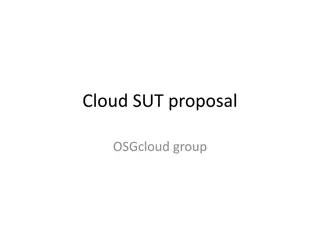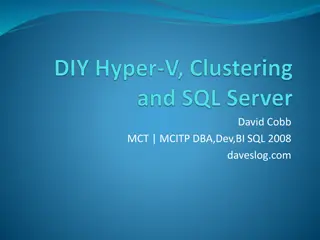Architecture-Aware Distributed Resource Management for Virtualized Clusters
A-DRM is a novel approach that addresses challenges in distributed resource management for virtualized clusters. It considers microarchitecture-level resource interference, enhancing migration decisions. The paper discusses the design, implementation, and evaluation of A-DRM, offering insights into its benefits for optimized cluster performance. Further exploration includes background on virtualized systems, live migration, and the use of microarchitecture and performance counters. This reference paper provides valuable insights on quantifying shared on-chip resource interference effects in consolidated virtual machines.
Download Presentation

Please find below an Image/Link to download the presentation.
The content on the website is provided AS IS for your information and personal use only. It may not be sold, licensed, or shared on other websites without obtaining consent from the author.If you encounter any issues during the download, it is possible that the publisher has removed the file from their server.
You are allowed to download the files provided on this website for personal or commercial use, subject to the condition that they are used lawfully. All files are the property of their respective owners.
The content on the website is provided AS IS for your information and personal use only. It may not be sold, licensed, or shared on other websites without obtaining consent from the author.
E N D
Presentation Transcript
Embedded System Lab. A_DRM: Architecture-aware Distributed Resource Management of Virtualized Clusters H. Wang et al. VEE, 2015 tuckdae@naver.com Embedded System Lab.
Table of contents Background Problems & Challenges Reference paper A-DRM A-DRM : Design A-DRM : Implementation Evaluation Conclusion Reference Embedded System Lab.
Backgound Virtualized systems Virtual machine can interact independently with other devices, applications, data and users as though it were a separate physical resource DRM(Distributed Resource Management) Virtualized cluster Para-Virtualization / Full-Virtualization Embedded System Lab.
Backgound Live migration The process of moving a running virtual machine or application between different physical machines without disconnecting the client or application High resource utilization and energy savings Microarchitecture / Performance counters Performance Monitoring Unit hardware performance counters To provide clear and accurate performance information to the software developer IPC (Instruction Per Cycle) Embedded System Lab.
Problems & Challenges DRM schemes usually use operating-system-level metrics CPU utilization, memory capacity demand and I/O utilization DRM schemes are oblivious to microarchitecture-level resource interference A-DRM takes into account microarchitecture-level resource interference when making migration decisions in a virtualized cluster Embedded System Lab.
Reference Paper Cuanta: Quantifying Effects of Shared On-chip Resource Interference for Consolidated Virtual Machines this paper focus on the performance impact of consolidated applications due to shared on-chip resources such as the lastlevel cache space and memory bandwidth An average prediction error of less than 4% is achieved across a wide variety of benchmark workload Embedded System Lab.
A-DRM : Design Profiler monitor resource usage/demands and report them to the controller periodically Composition CPU and Memory profiler, architectural resource profiler Controller detect microarchitecture-level shared resource interference leverage this information to perform VM migration. Composition Profiling Engine, Architecture-aware Interference Detector, Architecture-aware DRM policy, Migration Engine Embedded System Lab.
A-DRM : Design - Controller Profiling Engine The profiling engine stores the data collected by the profiler Architecture-aware Interference Dectector It is invoked at each scheduling interval to detect microarchitecture-level shared resource interference Architecture-aware DRM policy It is used to determine new VM-to-Host mappings to mitigate the detected interference computes the increase in LLC miss rates at each potential destination host, to quantify the cost and benefit / <contended host, VM, potential destination> Migration Engine The migration engine is then invoked to achieve the new VM-to-Host mappings via VM migration Embedded System Lab.
A-DRM : Implementation A-DRM use the Linux performance monitoring tool perf to access the hardware performance counters Memory Bandwidth Measurement in NUMA System Cost-Benefit Analysis <src, vm, dst> Cost VM Migration Performance Degradation at dst Benefit Performance Improvement of vm Performance Improvement at src Embedded System Lab.
Evaluation Workload Characterization there is no strong correlation between memory capacity demand and memory bandwidth (left figure) generally, workloads that consume low memory bandwidth exhibit a high LLC hit ratio (right figure) Embedded System Lab.
Evaluation A-DRM Case Study we conclude that by migrating VMs appropriately using online measurement of microarchitecture-level resource usage Embedded System Lab.
Conclusion A-DRM can enhance the performance of virtual machines by up to 26.55% (average of 9.67%), A-DRM improves the average cluster-wide memory bandwidth utilization by 17% (up to 36%) Results show that being aware of microarchitecture-level shared resource usage can enable A-DRM scheme to make more effective migration decisions Embedded System Lab.
Q & A Embedded System Lab.
Architecture-aware Interference Detector Architecture-aware DRM policy Embedded System Lab.
Evaluation Performance Studies for Heterogeneous Workloads Embedded System Lab.
Evaluation Sensitivity to Workload Intensity Embedded System Lab.
Evaluation Parameter Sensitivity The performance of A-DRM can be affected by control knobs such as the MBW_Threshold, live migration timeout, and the sliding window size evaluate the impact of these different parameters Embedded System Lab.
